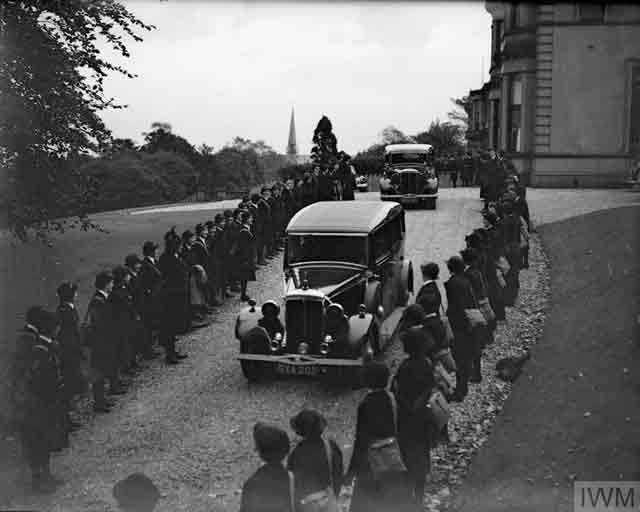Wednesday 15 October 1941
 |
| The British, Polish, and Australian troops at Tobruk have settled down to routine garrison duty since the struggles of the summer. Here, on 15 October 1941, two soldiers use gas masks while peeling onions for dinner. |
Eastern Front: After dark on
15 October 1941, the Soviet troops of 51st Army, 9th Independent Army and Separate Coastal Army holding the pocket at Odesa break contact with the Romanian troops surrounding the city and head to troop transports. This is the 72nd day of the siege, a far longer period of time than anyone expected. The Soviet Black Sea Fleet ships take the 35,000 evacuees (including both soldiers and civilians) to Sevastopol in the Crimea, where they are needed to defend that area next.
 |
| "A discarded Italian bomb is blown up beside a Matilda tank near Tobruk. The resulting craters were used to hide the tanks, 15 October 1941." (© IWM (E 6022)). |
During their evacuation, the Soviet troops set off explosives in Odesa that destroy port facilities and other installations that the Germans can find useful. The Soviets board two cruisers, four destroyers, and smaller ships for the perilous passage east. During the evacuation, Heinkel He 114 seaplanes of the Romanian Naval Air Force successfully stop and capture a Soviet armed freighter.
 |
| HMCS Columbia. On 15 October 1941, HMCS Columbia joins Convoy SC-8, under fierce U-boat attack in the North Atlantic. Ultimately, nine Allied ships are sunk before they reach port in England. |
The fall of Odessa is important for a number of reasons. It is a very useful port for supplying the advanced Wehrmacht troops advancing further east. It frees up Axis troops, though Romania begins discharging a large portion of its own forces soon after the city's capture in the belief that its part in the war now is largely over - thus, this advantage is not as great as it might first appear. The Luftwaffe and Romanian Air Force now can operate from the city's airfields and serve as a defense against Red Air Force bombing attacks on the Romanian oilfields further west. The capture of Odessa is the most significant achievement by any of Germany's satellites throughout the entire war. It marks a high point of their achievements - though, of course, nobody can know that at the time.
 |
| "HRH The Duchess of Kent with Vice Admiral B. C. Watson, CB, DSO, at the saluting base during a march past of WRNS." WRNS an acronym for Women's Royal Naval Service, the women's branch of the British Royal Navy during World War II. Greenock, 15 October 1941. © IWM (A 5817). |
Romania now can develop its new Transnistria Governorate (not to be confused with a later government in the 1990s). This is a significant area of 44,000 km2 and a population of 2.3 million inhabitants. Romania divides Transnistria into 13 counties: Ananiev, Balta, Berzovca, Dubasari, Golta, Jugastru, Movilau, Oceacov, Odessa, Ovidiopol, Rîbnița, Tiraspol and Tulcin. The Romanians begin a process of Romanization. The Romanians also deport between 150,000 and 250,000 Ukrainian and Romanian Jews were to Transnistria, where they are held in ghettos and camps. Many of these unfortunate people perish due to inadequate living conditions. Those who collaborate with the Romanians - or simply are suspected of collaborating with them - face horrors of their own when the Soviets manage to recapture the region in 1944.
 |
| Finnish troops stand in front of a Panzer 1 in Finland, 15 October 1941. The small Panzer 1 was obsolete by late 1941 but still useful for training, scouting, and some missions on secondary fronts. |
Holocaust: German authorities begin transporting approximately 183,000 German, Austrian, and Czech civilians of Jewish or suspected Jewish ancestry to ghettos, transit ghettos, killing centers and killing sites in the Baltic States, in Belorussia, in the Generalgouvernement, and the Lodz ghetto. The rail network is the primary means of transport, so the Reich Security Main Office (RSHA) coordinates the moves with the rail schedules established by the Transport Ministry - which also is responsible for supplying the troops in the East. This means that any space used by the RSHA for these deportations cannot be used to equip, feed, and clothe the men fighting in the Russian winter.
 |
| "HRH The Duchess of Kent leaving after her visit." This was a visit by HRH to the WRNS Headquarters at Greenock. Note the WRNS lined up along the road to bid her farewell. © IWM (A 5822). |
October 1941
October 1, 1941: Germans and Finns Advance in USSR
October 2, 1941: Operation Typhoon Broadens
October 3, 1941: Air Battles Near Moscow
October 4, 1941: Stalin Contemplates Defeat
October 5, 1941: Hoth Goes South
October 6, 1941: First Snowfall After Dark
October 7, 1941: Stalin Gets Religion
October 8, 1941: FDR Promises Stalin Aid
October 9, 1941: FDR Orders Atomic Bomb Research
October 10, 1941: Reichenau's Severity Order
October 11, 1941: Tank Panic in Moscow
October 12, 1941: Spanish Blue Division at the Front
October 13, 1941: Attack on Moscow
October 14, 1941: Germans Take Kalinin
October 15, 1941: Soviets Evacuate Odessa
October 16, 1941: Romanians Occupy Odessa
October 17, 1941: U-568 Torpedoes USS Kearny
October 18, 1941: Tojo Takes Tokyo
October 19, 1941: Germans Take Mozhaysk
October 20, 1941: Germans Attack Toward Tikhvin
October 21, 1941: Rasputitsa Hits Russia
October 22, 1941: Germans Into Moscow's Second Defensive Line
October 23, 1941: The Odessa Massacre
October 24, 1941: Guderian's Desperate Drive North
October 25, 1941: FDR Warns Hitler About Massacres
October 26, 1941: Guderian Drives Toward Tula
October 27, 1941: Manstein Busts Loose
October 28, 1941: Soviet Executions
October 29, 1941: Guderian Reaches Tula
October 30, 1941: Guderian Stopped at Tula
October 31, 1941: USS Reuben James Sunk
2020






No comments:
Post a Comment